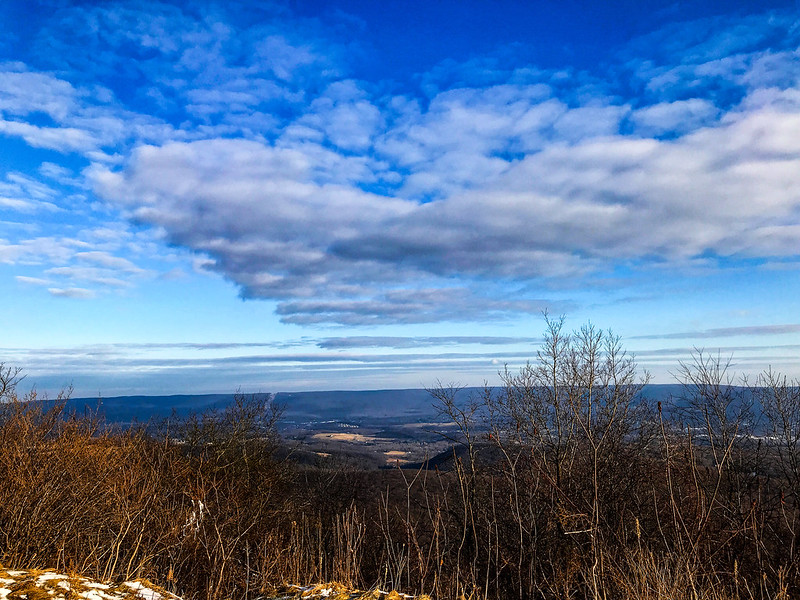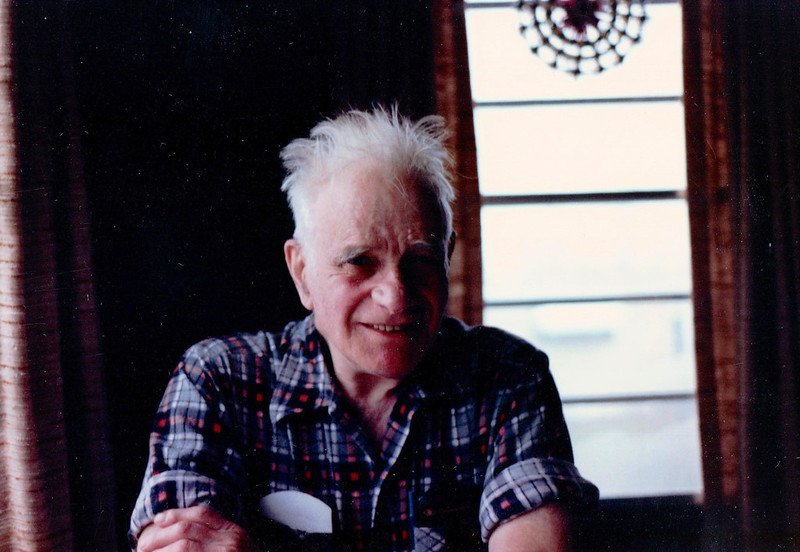
Tag Archives: family
Relics: Wind-up car and jalousie windows, car cigarette lighters
I can’t say we took any great American road trips when I was a child — mostly 200-mile jaunts to visit family in the Altoona area of Pennsylvania or rare shorter ones to local attractions like Niagara Falls or Letchworth State Park. The first car I remember was a powder blue Ford Falcon. With Virgil and me in the back seat picking on each other and wondering “Are we there yet?” after 25 or 50 miles, time and money may not have been the only reason we didn’t travel far or often.
Later, my dad bought a used van with two back seats. This was such a novelty that kids stopped by to pile in. All that room! Of course it was bare bones, a working man’s van, with none of the comforts of today’s SUVs and minivans, like DVD players or even — gasp! — cup holders. We “roughed it” back in those days with tap water or water from a roadside spring in Pennsylvania kept in a jug. We’d have to pull over to drink it. And we didn’t know about “hydration,” only thirst.
We had only an over-the-air radio — no Sirius, no subscription services tailored to our tastes. You might find yourself in a part of the country with only bland pop and country & western. Our series of bare-bones vehicles didn’t have 8-track tape decks or CB radios for chatting with passing truckers. I don’t think the radio played much of a role in our trips, except to get traffic and weather.
We had games like “punch bug,” in which being the first to see a Volkswagen Beetle on the highway entitled you to punch your annoying brother, sister, or friend. We also kept an eye peeled for “beavers,” station wagons with wood-paneled sides. We’d make a pulling motion to truck drivers to try to get them to pull their air horns. We liked the ones who accommodated us. I understand the tradition continues today, although with safety first (no startling of unaware drivers) and the hope it doesn’t provoke a modern road rage incident.
Of course there were no USB ports, but there were cigarette lighters — in 1965, a whopping 45 percent of Americans smoked. I’ve never bought a car, but it sounds like what Wikipedia describes as a “de facto DC connector,” or cigarette lighter receptacle, is more likely to be used to power portable accessories (“lights, fans, beverage heating devices, and air compressors for inflating tires”). I wonder if it can be used for e-cigarettes? J’s is used for an iPhone charger. With only about 15 percent of Americans smoking today, I suspect the car cigarette lighter as such has achieved “relic” status for many of us.
Neither the Ford Falcon nor the vans that followed had air conditioning save that offered by an open window and a speed-generated breeze. I don’t know how we held conversations on the open highway. Maybe we didn’t, other than, “He’s picking on me!” and “Are we there yet?” punctuated by “Ralph, STOP!” (My mother had imaginary brakes on her side and possibly a worn-out floorboard.)
Most cars sold in the U.S. now come with air conditioning as a standard; it’s a given, not a luxury — not so north of the border. Today we “wind” the windows down mostly to take photos, ask passers-by questions, pay entrance fees or talk to booth operators, and on occasion encourage a fly or mosquito to vamoose. I say “wind” even though the push of a button opens the windows (as long as they’re powered, that is).
In the old Ford Falcon and vans, you did wind the windows up and down, just like we used window winders to open and close the trailer’s jalousie windows. I had to look that term up — jalousie windows in campers/trailers/mobile homes were common in the 1950s and ‘60s, but aren’t anymore.
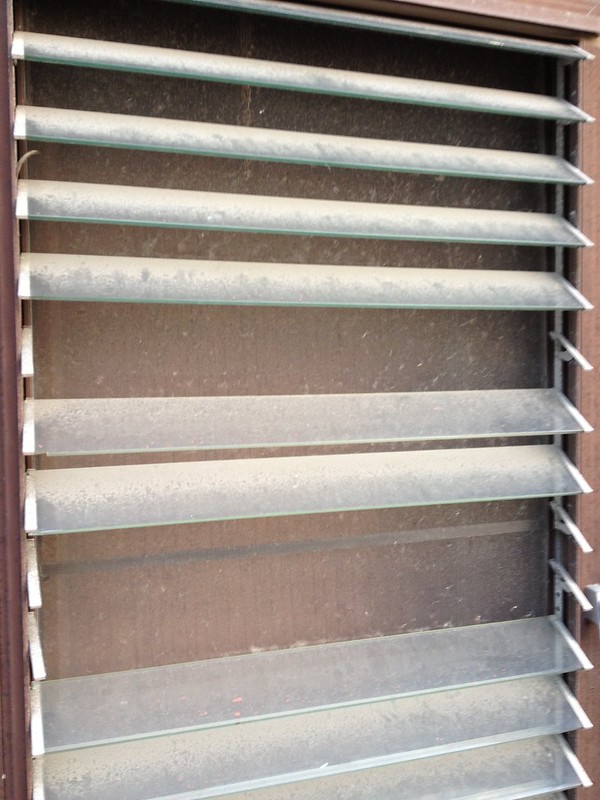
Although cars.com talks about “old-school manual crank windows that seem, especially now, from a bygone automotive era,” they’re also not quite a relic. People don’t want them for themselves, but they do want the lower car price. They’re also found in many trucks. The 2015 cars.com article concludes, “For now, at least, it’s clear there are enough price-conscious new-car shoppers to keep manual windows around.”
I’ve never been a smoker, and I don’t feel nostalgic about car cigarette lighters. As with push lawn mowers and clotheslines, however, I do miss manual windows and window winders. Power windows have their advantages when you spot something and want to take a photo or video quickly (although they make enough noise to scare off animals). On the other hand, when I wait in the car I don’t always remember to open the window when the power is on, so I resort to the alternative, awkward in a parking lot, of opening the door. It doesn’t sound like much, but sometimes I want to crank open the window.
At least it’s not because someone used the cigarette lighter.
Dream: “Wind! Wind! WIND!”
(The title is from The Thief of Bagdad. Grand Vizier Jaffar, played by Conrad Veidt, dramatically summons the sea wind to do his evil bidding.)
I was living with my parents in a trailer in a sweet location, probably with trees and gardens. The word seemed to be “idyllic.”
It became windy and windier, and the wind finally tore the trailer away. It felt like we were traveling smoothly down the highway, but I knew the stop would destroy the trailer and possibly kill us.
It didn’t.
We found ourselves in a city or town, in a narrow, darkened alley or street, the opposite of everything I had wanted or known. I was devastated. One of us found a window with a view of a field and trees, but the trees were weedy bird of paradise.
The wind took us away again on the same smooth ride. We saw we were headed toward water. I know everything we had would be ruined. I searched frantically for Pudge to try to save her but even after we stopped (and yet somehow ended up back on land) I couldn’t find her. I panicked and cried over the loss of my helpless innocent cat.
We were blown away again, and during this journey I found Pudge not only unharmed but dry and clean as though she had never been wet.
Next we were blown toward a sunny hillside. “Great,” my mother said. “Figures we’d be blown into and down the only hill in Illinois.” I started to tell her there are hills in southern Illinois in Shawnee National Forest, but it occurred to me a moment of fear and anger is not the time to educate someone.
As we bumped down the hill, I noticed how steep it was — steeper than any hill I’d seen.
I wondered how the trailer and we had survived these journeys and crashes. I kept hoping we’d land gently in a sheltered spot where the wind couldn’t grasp us.
We sailed toward a passing freight train in town, but curved off and didn’t hit it. That was a relief, but there was another track with a train in the next direction, and another in a third direction. It’s like we were in a triangle of trains, but I couldn’t work out how that could be possible in such a tight area without them hitting one another.
I knew at some point the trailer must disintegrate and we must die.
Elk, or wapiti, at the Benezette, Pennsylvania, campground
December 27, 2017: After seeking elk in the outlying areas of Benezette, we found a little herd at the campgrounds in town, which they favor. I handed my phone off to my cousin, who was in a better position to capture them. Benezette is part of the area that’s been rebranded “Pennsylvania Wilds” to attract adventurous tourists of the have kayak, will travel variety.
Hike and a picnic
Today is the 100th anniversary of my mother’s birth. I discovered this delightful clipping about a hike to a farm and a picnic with storytelling under a big tree she helped to organize. It could be straight out of Anne of Green Gables.
I love finding these blurbs. This and others are giving me new insight into my parents’ early lives pre-me.
Pennsylvania spring water
As a child, I didn’t think about water until I started visiting a friend whose family drank well water that smelled and tasted of sulfur. The odor permeated their house. “You get used to it,” she said. Accustomed to the tasteless taste of “city water,” invariably I felt thirsty the moment I arrived. I never got used to it.
Forty-five years ago the typical person didn’t carry a water bottle or buy bottled water. We drank whatever came out of the tap. Unswayed by Dr. Strangelove or decades of bottled water marketing, I still do, and that’s what I fill my insulated water bottles with when traveling.
On our annual pilgrimage to Pennsylvania in the 1960s and early 1970s, we used to stop at a couple of roadside springs and fill a jug or two with spring water. We didn’t need to. Our “city water” in New York was fine with us — well, as fine as any water in our polluted world can be. There didn’t seem to be any objection to our hosts’ water, either. By the time I was sentient, we were no longer staying with anyone who lacked indoor plumbing. My guess is my parents liked the idea of getting water from a roadside spring and preferred it as a rare treat. I did too. Water straight from a spring — as nature intended. (We didn’t boil it, either.)
Later we stopped at the usual places and found signs indicating the water was too contaminated to drink — the effects of coal mining. My heart broke a bit at the loss of a tradition and the sense the earth itself was dying one roadside spring at a time. After all, I was being raised in the era of the fiery Cuyahoga River, algae-choked Lake Erie, and the horrors of Love Canal.
I wish I could remember where those springs were and find out if anything has changed.
According to findaspring.com, which seems to be defunct, Pennsylvania leads the U.S. in the number of listed springs with 84. New York is second with 59, while Illinois lags behind with only 17 shown.
When I was visiting my cousin for Christmas 2018, I found out they’ve taken to collecting and drinking spring water. My cousin hinted, however, that the spring is far from picturesque. In my mind’s eye, I saw an ugly, chipped-up plastic pipe protruding from an ugly, denuded hillside in town. Something like that.
The spring is south of Tyrone, so we used a visit to Village Pantry as an excuse to get some water. It’s on a lightly traveled road paralleled by a stream, Elk Run, that seems to cross back and forth under it in several places.
My cousin and his wife quickly set up an efficient two-person jug-passing and -filling operation while I meandered back and forth across the road, drinking in (so to speak) the sights and sounds of the spring and Elk Run on its journey.
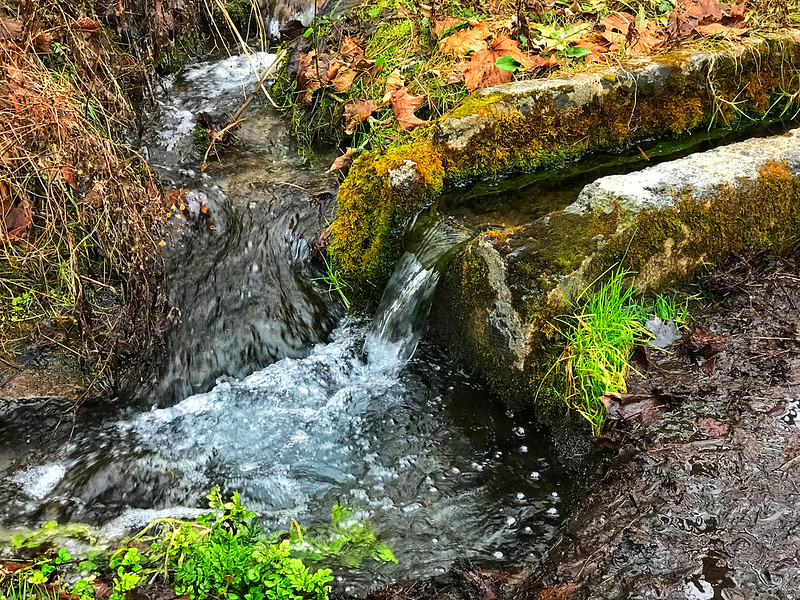
When a house buyer sees a stream, he pictures flooding, damage, and dollars. I picture myself at a church picnic at Chestnut Ridge, a lifetime ago, walking on 18-Mile Creek, listening to its gushing and trickling, soaking in the sight of countless tiny drops, waterfalls, and eddies, and hoping to spot tadpoles, frogs, minnows, and fish in the clear water reflecting a perfect summer sun filtered on the edges by healthy trees. I had no way of knowing how ephemeral that experience would be.
Memories.
I don’t know how clean or safe the water from this spring is. As I said, it’s south of Tyrone, whose paper mills wafted their distinctive odor through my aunt’s screen door seven or eight miles away in Bellwood. I’ve seen a discussion about agricultural runoff in the area as well, although many think it’s insignificant.
Elk Run appears to be a tributary of the Little Juniata River. I once told my dad I’d seen a leopard frog in the Little Juniata as it runs past Logan Valley Cemetery in Bellwood. He made a wry comment about it, perhaps “How many legs did it have?” Now he and my mother are buried in Logan Valley. Cemetery, within earshot of the Little Juniata. Water, however clean it is or is not, connects us — all of us. We shouldn’t forget that.
Curious about the current state of the Little Juniata, given I’d been handed two bottles of spring water, I found out it’s not as bad as I thought.
Well, the Little Juniata River is not well-known nationally, primarily because it’s only been a trout stream since around 1975. The reason being that prior to that it was literally an open sewer.
Bill Anderson, president of the Little Juniata River Association
After decades of pollution and a “mysterious pollution event in 1997,” we have brown trout fishers to thank for cleaning up the Little Juniata and shoring up its eroding banks.
We want to make sure this resource stays open for our children and grandchildren.
Bill Anderson
This would have made Dad happy. And he didn’t fish.
Stop the presses! Family members visit other family members in Williamsport
I jest, but this does bring back memories of visits back and forth when I was young enough to be bored but old enough to appreciate any change in routine. This was a visit without us, though.
Schirf state visit to Bellwood, Pennsylvania
This morning I, “Dianne Schirg,” made this marvelous discovery from a simpler time when a family visit to Bellwood, Pennsylvania, was noteworthy.
Relics: Fotomat
Do you remember Fotomat? You drove up, dropped off your film, and got your photos back the next day. (I can’t swear they were always on time.) If you don’t recall the distinctive Fotomat kiosk, you may be familiar with the idea from That 70s Show. The name was disguised as Photo Hut, which loses the charm of the alternative spelling common in the era’s advertising and the nod to the old-school automat.

Fotomat seems like a natural extension of mid 20th-century culture. Interstates, drive-in restaurants and movie theaters, motels (motor hotels) — why not drive-up film processing and prints?
In Hamburg, New York, the nearest Fotomat couldn’t have been any closer to us. It was plopped near the outer edge of the South Shore Plaza parking lot, where my dad could stop on the way home from work or to the store. If he’d been so inclined (and willing to dodge Route 20 and parking lot traffic), he could have walked over from the trailer park.
My dad liked Fotomat because they used Kodak processing and film for his primarily 126 film prints. He could be snobbish about certain brands, and Kodak was one of them. If I remember right, our South Shore Plaza Fotomat and others switched to another brand, possibly Fujifilm. That’s when and why he began to use Fotomat less frequently.
According to Wikipedia, the photo minilab made Fotomat obsolete in the late 1980s. The brand continued online with photo storage and editing until 2009. It’s funny to think of a brand built upon its unique physical locations and look surviving (barely) as a virtual service.
South Shore Plaza, opened in 1960, died a long, painful death, finally torn down and replaced by a Wal-Mart in 2009. I’d guess the Fotomat succumbed long before the plaza emitted its final gasp.
As we know from many creepy images of Poconos resorts or old amusement parks, when an idea or place is abandoned, it’s sometimes left in place until it falls apart or something comes along to take its place. Some of the 4,000 Fotomat booths remain, repurposed. Drive-through coffee or cigarettes, anyone?

A former Fotomat drive-through kiosk in Glendale, California, now a cigarette kiosk
Further reading: Democrat & Chronicle, “Whatever Happened To … Fotomat?”
Wopsononock Mountain, or Wopsy, in Blair County, Pennsylvania
Poor scans of photos taken in 1988 remind me of my dad’s move to Pennsylvania. We had visited family there at least once a year during most of my childhood. As my dad got older, my parents and their family members started to have health issues, people died, and I went to college, we stopped going. By the time I returned to the Altoona area, it seemed strange, yet familiar. What felt oddest was getting there mostly by Amtrak vs. wending our way through southern New York and Pennsylvania on Rte. 219. I felt like a stranger in a strange land, with my mother and many of her family already gone.
Since it was one of my first visits in a long time, my dad’s sister took us to several area attractions. I’d never seen Baker Mansion. The kitchen trough for fresh fish fascinated me. I also recall servants’ quarters at the top of the house. I imagined helpless cooks and maids trapped in the attic while fire raged below, the small windows useless for escape.
We also went to an overlook, but I paid little attention to the name (if it was mentioned) or the location. We didn’t have Google Maps in our pockets for reference 30 years ago. I remember only the loveliness of the view — and that when I went to look over, I slid on shale or gravel and tumbled partway down the hill, my fall slowed, then stopped by a tangle of brush. I laughed.
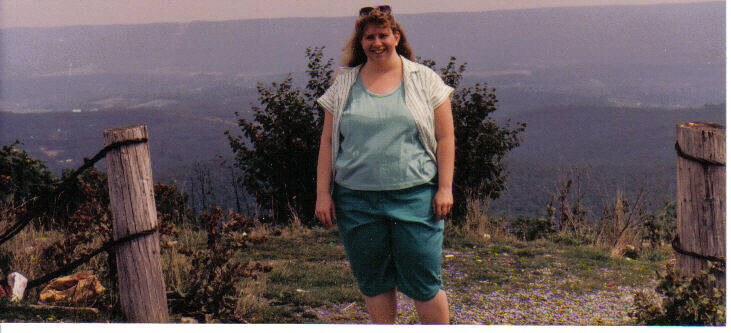
During my Christmas visit in December 2018, I mentioned the photo to my cousin and his wife, who agreed I must be talking about “Wopsy” (Wopsononock Mountain). It’s directly across from Pinecroft.
From the top of Wopsy, we could see the housing development that replaced the woods on their hill, the old landfill, and perhaps a corner of their house or garage. I realized that the towers I see from their road are where we were standing on Wopsy.
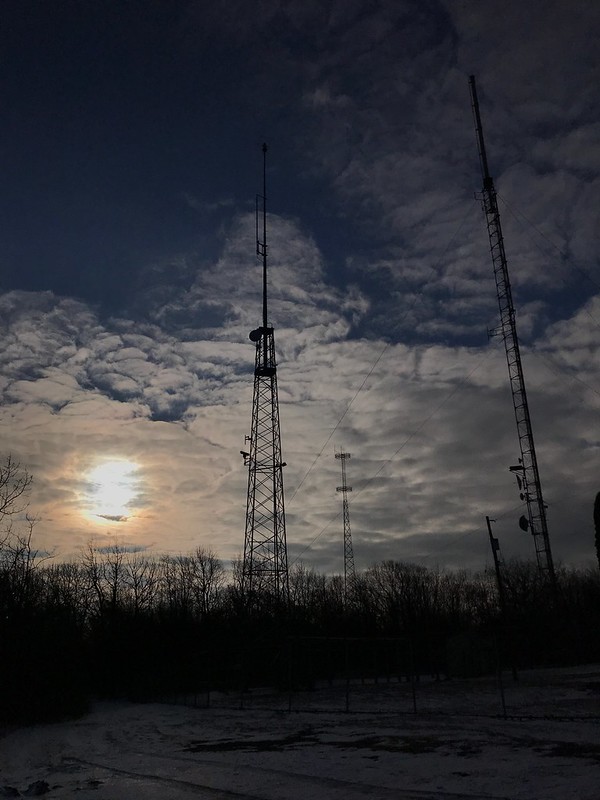
Where once there were wooden fence posts there’s a long, high guardrail covered with grafitti; my cousin feels the area’s not that safe. Devil’s Elbow, which we may or may not have passed, is supposedly haunted by the “White Lady of Wopsononock.” If you don’t believe in the White Lady, you can check out Mindhunter on Netflix about the murder of Betty Jean Shade, whose body was found in an informal trash dump on Wopsy.
What made the death of Betty Jean Shade so different was the violence to her body, and in an effort to determine who killed her, investigators, through the aid of former FBI Agent Dale Frye, who served the Altoona area, turned to the fledgling FBI effort at its Quantico, Va., facility, which was attempting to perfect psychological profiling.
Phil Ray, Altoona Mirror
Betty Jean Shade was found in 1979, nine years before my visit. If I had known that, I don’t think I would have smiled so broadly. But the overlook is still beautiful.
